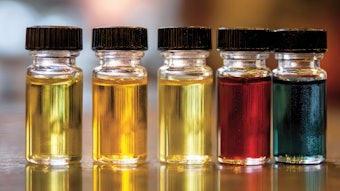Geranium oil remains one of the most important oils employed in perfumery formulations. With production declining in some countries, opportunities for new suppliers are greater than they were ten years ago. This article describes a comparison of the physiochemical data and chemical composition of an oil distilled from a cultivar of a Pelargonium sp. hybrid developed in Australia, and compares the data with that obtained from commercial geranium oils.
Experimental
Voucher specimens of this Pelargonium cultivar are lodged with tbe National Herbarium of New South Wales, Sydney (Voucher No. R94015). Under sub-tropical conditions in the Lismore district (28°50′S, 153°20′E), living material was cultivated in well-drained Krasnozem soil at twelve trial plots, each containing fifteen plants spaced one meter apart within 9.2 square meters.
Refractive indices were measured on an Abbe Atago 15288 refractometer, optical rotations on an Atago Polax polarimeter, relative densities using 1 ml glass pycnometers and solubility in alcohol using 70% ethanol. Gas chromatography on Hewlett Packard 5890 and Shimadzu 14B gas chromatography using H2 at 1 ml/min as carrier gas, flame ionization for detection and BPI, AT35 and BP21 m x 0.2 mm FSOT columns. Gas chromatography-mass spectrometry was performed on a Shimadzu QP 1000 using a 30 m x 0.22 mm DB17 FSOT column for both EI (70 eV and 20 eV) and CI (isobutane) determinations, GC and GC/MS determinations were programmed from 50° (1 min) to 250° (9 min) at 10°/min. GC/lR determinations used a 50 m x 0,22 mm BPS FSOT column programmed from 40° (0 min) to 290° at 4°/min with a Digilab Tracer detector. Assignments were based on Retention Indices, Mass Spectra, Infrared Spectra, Liquid Chromatography and GC peak enhancement following the coinjection of authentic constituents.










